Carl Nielsen is the only composer of the first rank that remains almost totally unknown. There are six symphonies at the center of Nielsen’s art although he wrote in all forms. Most critics and musicologists agree his orchestral music ranks with the great symphonists of the 20th century like Mahler, Shostakovich, Sibelius, and Vaughan Williams.
I certainly cannot do the works justice in this first column alone and will examine each symphony in later articles as well as some of the smaller orchestral works.
Nielsen speaks in a unique, but absolutely tonal language. The music hits you with its originality and energy on the first listen. Once heard one wants to explore more of this unique and powerful musical voice.
The launch of the long-playing record allowed record companies to move beyond the well-known composers they recorded on 78s. With LPs, record companies found listeners were willing to purchase less well-known works. Classical sales of LPs easily exceed other forms of music on LP in the 1950s with the 45s finding better sales in other types of music. High Fidelity magazine’s content was more than 50% music when it started in 1954.
Nielsen Rediscovered by American Conductors and Orchestras.
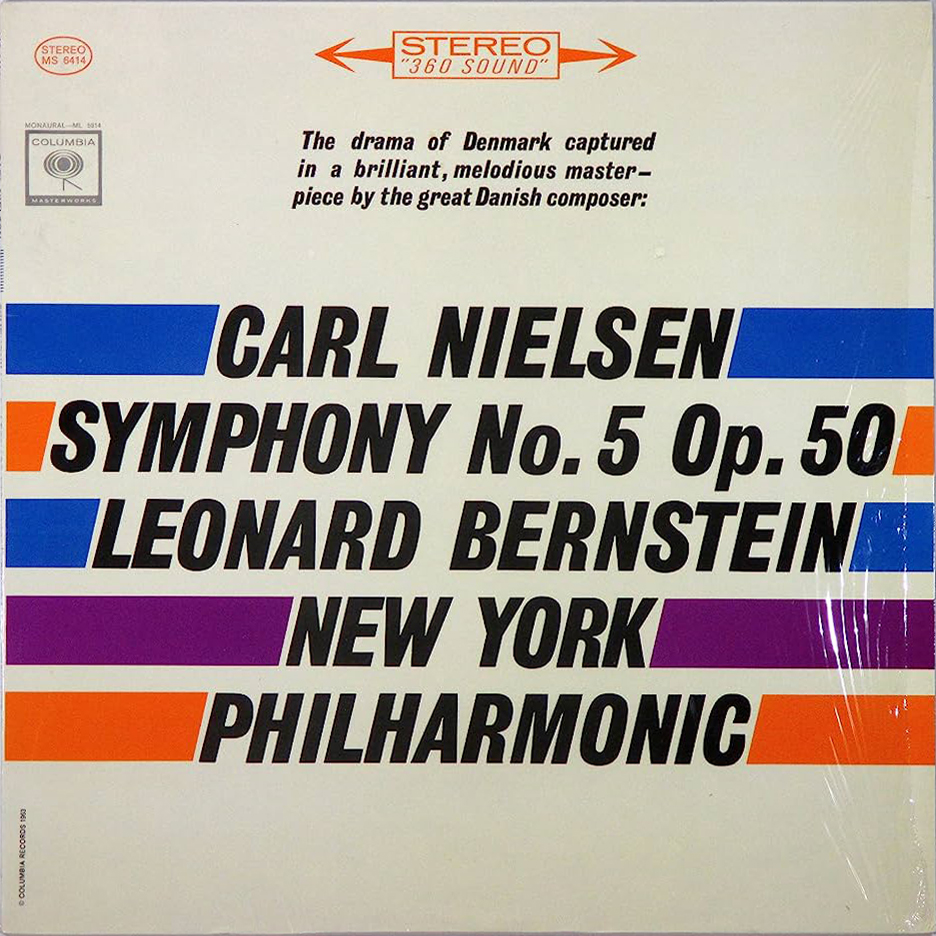
Nielsen was one of the composers with whom the record labels took an interest. Mahler is not the only composer Leonard Bernstein launched with his LP set of the symphonies. His 1961 performance of Nielson’s greatest symphony, the 5th, which appeared on LP in 1963 lit a fire under critics and music lovers. Recording companies quickly went on to explore him in more depth.
The Bernstein is the first stereo recording. David Fanning wrote a whole book about just the 5th symphony, in English. One of the chapters looks at the 26 recordings that existed until 1993. Fanning, with all the later competition, still found this recording to be excellent following the score markings closely.
Wikipedia reports a performance of the 5th symphony by “the Danish Radio Symphony Orchestra conducted by Erik Tuxen at the 1950 Edinburgh International Festival, caused a sensation” but he was soon forgotten again. The Bernstein LP would not be forgotten.
It has been recently remastered and is available as a high-resolution download from Presto Music in the UK. These latest CBS remasters of Bernstein’s 1950s – 1960s recordings make a significant audio quality improvement over the original LPs and first CD releases, but the state of art sound revealed in RCA and Mercury remastering is not to be found here. The high-resolution version can be found on Qobuz.
I will be producing an extended discussion of each Nielsen symphony in later columns so I will give one a brief outline here. Symphony #5 is a post-war (World War 1) work from 1920 but it is very much a war symphony in two movements. Andrew Huth in liner notes for the 2nd Herbert Blomstedt recording of the 5th says the first movement is a massive conflict while the 2nd movement is a means of regeneration after the conflict. The process of regeneration is not linear. The work may appear to be coming to its positive conclusion only to reveal we have not arrived and need to take another path.
The Nielsen 5th is considered by many musicologists as one of the great symphonies, period. Of all his symphonies it is the most performed by American orchestras, but even still the event is rare.
It is in a more advanced musical language than the earlier 4 symphonies although it is fully tonal. His musical voice has expanded and become more complex in tonality, orchestration, and structure. I might suggest leaving it until you know the first 4 symphonies but in 1963 it was the only Nielsen symphony easily available in the US and it sold well enough for Columbia to go back and make more.
Bernstein in Denmark.
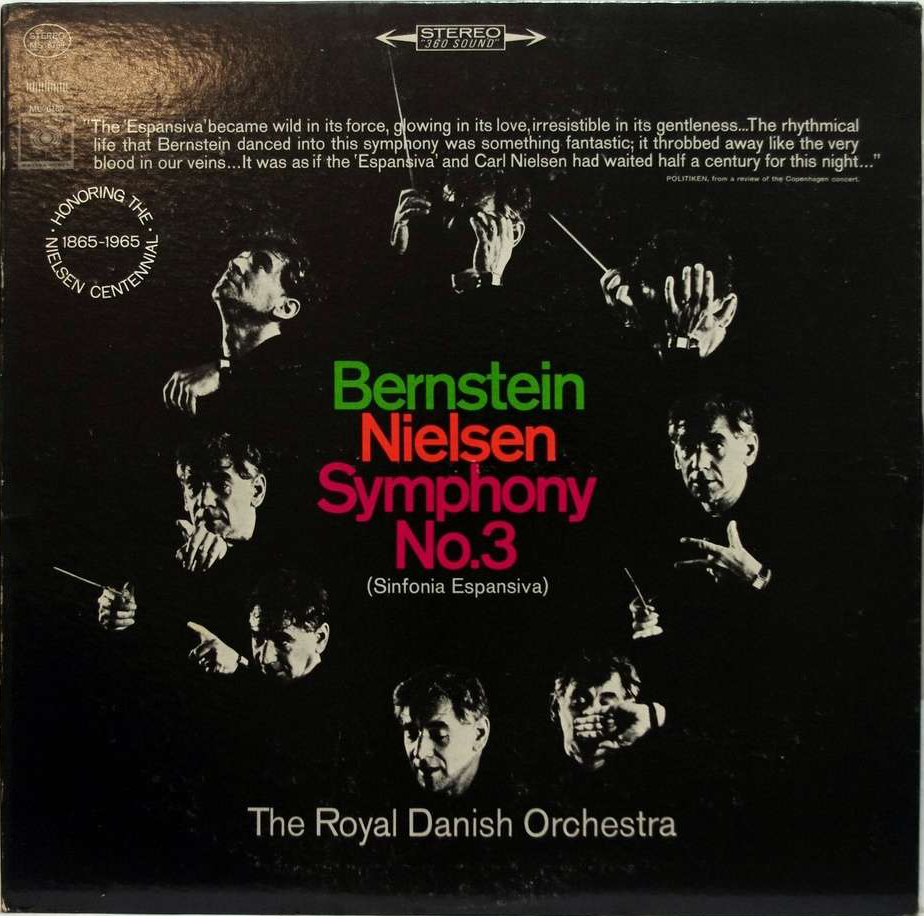
Carl Nielsen was born in 1865 making his 100th anniversary in 1965 a spark to get all the symphonies released on LP.
Bernstein made a pilgrimage to Denmark in 1965 to perform a full concert of Nielsen including the 3rd symphony with the Royal Danish Orchestra. It was a big deal. The concert was attended by King Frederik IX.
Bernstein picked up a major prize. In the citation:
“When your gramophone recording of Carl Nielsen’s Symphony No 5 became known here in Denmark a few years ago, the question arose in Danish circles of how we, in right and proper ways, could express our recognition of the significant contribution you had therefore to the understanding of our composer outside the country’s own borders”.
The recording was released in 1965. It has been remastered in high resolution, again available on Presto Music. Here the sound is much better. The performance was broadcast on Danish TV, and I expect the Danish engineers were dealing with a better recording space in the Copenhagen hall than The Manhattan Center and the Danish engineers were after a less aggressive sound than is normal for Columbia . YouTube has a video of Bernstein with the Royal Danish Orchestra performing Nielson’s 3rd Symphony from that same broadcast.
Symphony No. 3 is from 1910-1911. While the 5th is a haunted work written after the trauma of war, the 3rd radiates sunshine. It is with this symphony and this recording that listeners learned his special musical language that was worth multiple playings.
It is a symphony of sunshine and hope but it is not a clear calm day. It is filled with energy and forward movement that is at the core of Nielsen’s works. It starts with an ever-quickening series of chords leading to the energetic, life-affirming main theme. A calmer contrasting second theme is heard but the energy never let’s go in the development and concluding segments. This movement alone will hook you on Nielsen. The slow movement starts calmly with a more active element at the center then it calms down again with the surprise entrance of two wordless singers expressing pure joy.
In the 3rd movement, we are on the move again with energy only Nielsen can create. It is moving but it’s sunshine with contrasting material, but no storms hang around. One thematic element sounds like a Danish folk song. Nielsen said of the final it is “a hymn to work and the healthy activity of everyday life.” The movement is filled with energy and the exuberant conclusion is not forced but a reflection of the spirit of the complete symphony.
RCA joins the race to record Nielsen.
Now CBS was in a race with RCA to bring all the symphonies to LP. Ormandy produced a 6th symphony in 1965 and the 1st in 1967. RCA came in big time in 1967 with three recordings of Nielsen symphonies with three different conductors. Andre Previn conducted the 1st symphony.
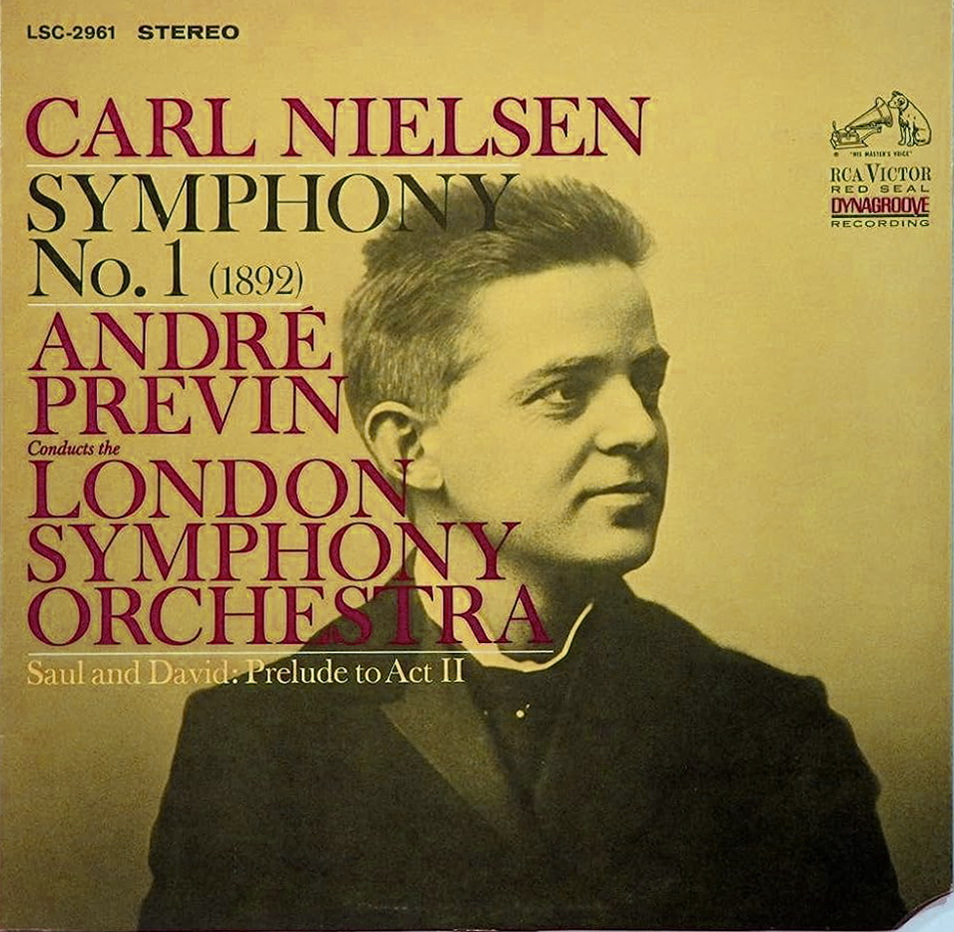
I have a photo of only the Previn first symphony from the RCA above. The Ormandy performances were on a CD long discontinued. No CD-quality files are available for download, and it does not stream.
The remastered Previn is available for download on the UK Presto Music site as well as streaming. Previn was with RCA only for a short period of time, but he produced a number of recordings still considered benchmarks with the London Symphony including this one. The sound of the work RCA did with Previn has been praised and one can hear why in this recording.
The 1st symphony is an early work from 1891 – 1892. It is his first major orchestral piece. It has some Brahms and Dvorak in it, but it is unmistakably a work of Nielsen with all the forward-moving energy of his mature works. Previn understands how to bring out the energy and if it has flaws of a youthful composer starting out, Previn’s interpretation hides them. It is a really fun work to get to know but the fully mature voice of Nielsen does not emerge until the 2nd symphony.
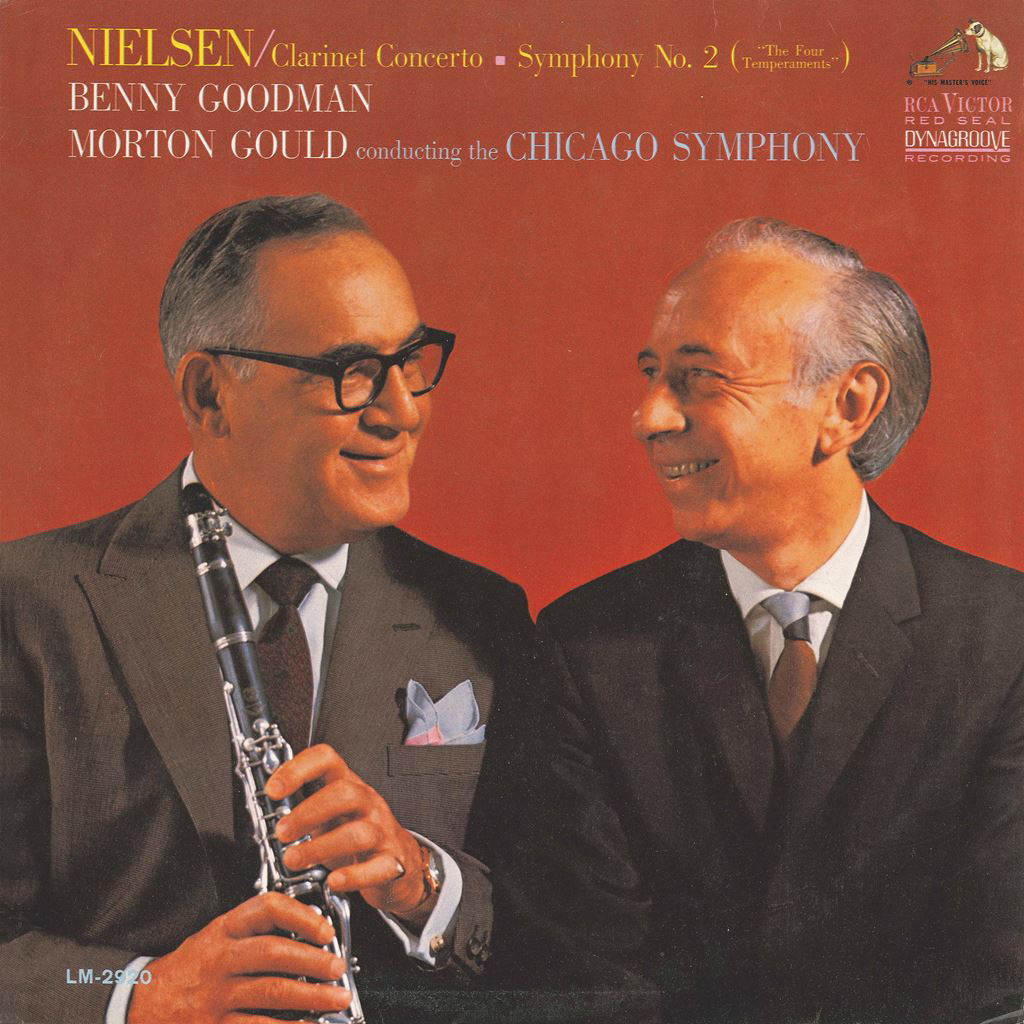
RCA chose Morton Gould to conduct the 2nd with the Chicago Symphony with prime attraction being Benny Goodman doing the Clarinet Concerto which was written after all 6 symphonies. I refer you to my full article on the 2nd symphony and this performance.
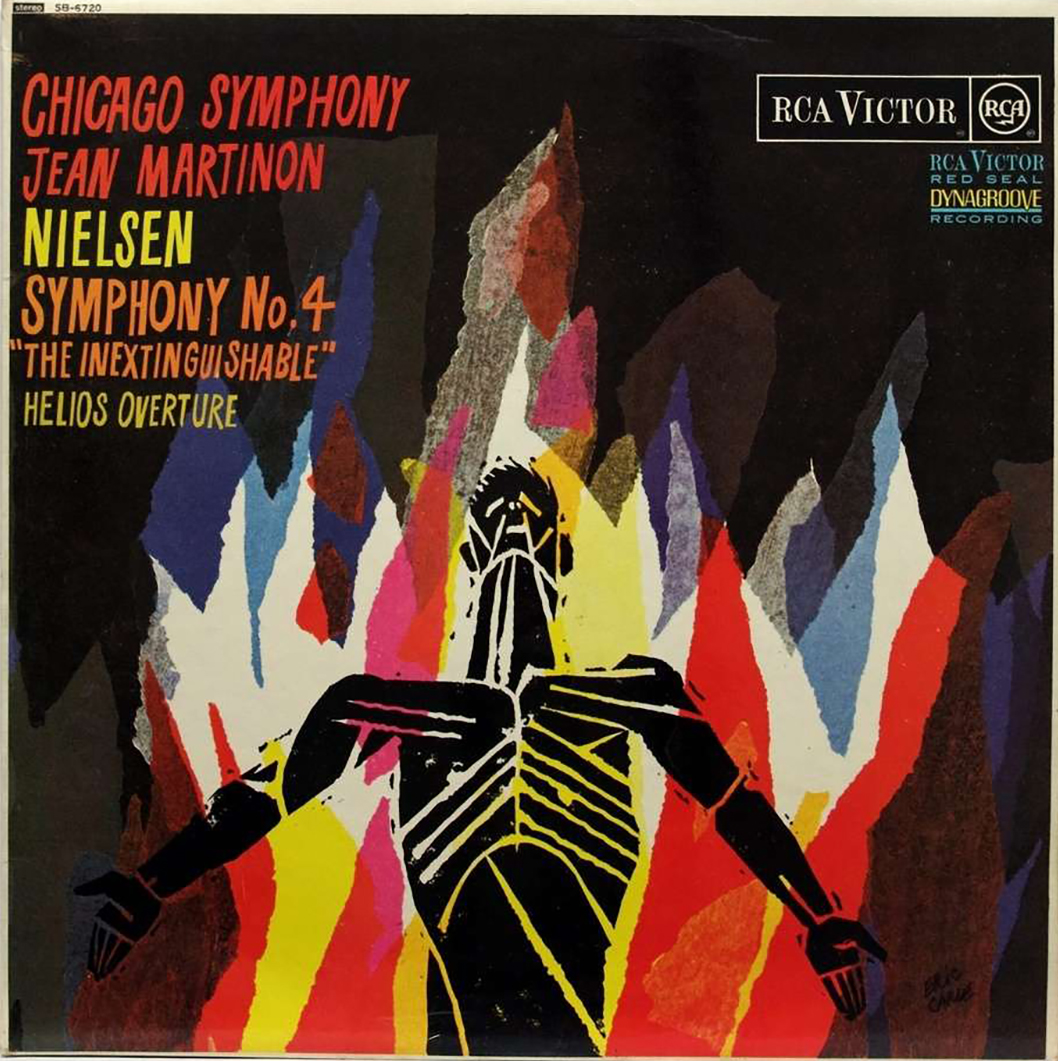
In the same year, RCA released another Chicago Symphony recording with its then-music director Jean Martinon conducting Symphony No. 4.
This recording has been remastered as part of a box set of all the Jean Martinon recordings when he was music director of the CSO. These recordings are after the Chicago Hall’s renovation which made it a better place filled with an audience, but a less effective recording studio when empty. Still, the sound is excellent.
While it sounds strange that a French conductor would produce a recording of Nielsen that is still a benchmark, the complete box set makes it clear Martinon was a master interpreter of 20th-century music regardless of where it was written.
The current remastering of the 4th symphony is only available for lossless download as part of the full box set. An earlier download, on a single CD, with the Gould 2nd symphony has an editing problem. What should be one continuous work has a large break at the point the LP would have been turned over. Some critics were driven crazy by this producing reviews that said little else. RCA heard enough complaints to be sure to fix it in the box set.
If you are streaming this, you’ll need to find the complete Martinon box set version of the 4th symphony, not the earlier single CD reissue. A search on Qobuz brings up the early one. Search for “Martinon” to find the big box, not “Nielsen.”
The 4th symphony was written during World War 1 from 1914 to 1916. Denmark was neutral but reports of the horrors of the war could not be escaped. Nielsen gave it the title “The Inextinguishable.” It is not necessary to know what was going on around the composer or what the title is. Music is an absolute art. You do not have to know the composer’s program at all. What you do know is you are listening to an important, highly original, work of art. A great composer has a direct path of communication to the listener just with the notes. Extracting a small part of the composer of this work “In other words the opposite of all program music, despite the fact that this sounds like a program”. The full composer is to be found in the URL below:
www.theguardian.com/music/tomserviceblog/2014/mar/04/symphony-guide-nielsen-fourth-tom-service
The work is in 4 parts played without break. This is the most recorded of the Nielsen symphonies. The 4th movement has two tympani on each side of the stage in a mock battle. Even Herbert von Karajan could not resist making a recording with the Berlin Philharmonic. Zubin Mehta recorded it with the LA Philharmonic.
You would expect this would be used as Hi-Fi demo music, but it would clear the room. It’s not Holts’s Planets but is a deeper more complex music language of one of the great composers using music to convey what the composer was experiencing at the time it was written.
I have no space here to give any description of the massive work. The 1st movement is filled with the energy of the openings of the earlier symphonies, but this is a dark energy. The slow 3rd movement touches the soul with the tortured music Neilsen creates. One feels the depth of the movement which is intensified by the fast dark music surrounding it. At the end of the tympani battle, the music turns optimistic as tympanies re-enter driving the work to what appears to be an optimistic conclusion, but undercurrents still exist as it concludes. Symphony #5 will look at the war again after its conclusion. Another battle and another resolution but the works have little in common as is to be expected as a great artist progresses his art forward.
Between RCA and Columbia, one could assemble performances of the symphonies that have stood as benchmarks . These 6 LPs, including the now un-obtainable, Ormandy 6th, came to be known as the “American Cycle” In 2023 the American cycle is still considered some of the finest Nielsen to have been released commercially. If I could only have one, this would be it.
Bernstein would later record the 2nd and 4th but both were disappointments. RCA lost interest and never finished the cycle. A 5th symphony did appear under Alexander Gibson and the Scottish National Orchestra in 1978 which I only discovered when I looked at the Discogs list of all the recordings of music released on LP.
Early Complete Box Sets.
The first complete set of Nielsen symphonies appeared on the British Unicorn label (almost unknown in the USA) with the London Symphony under Ole Schmidt in 1974.
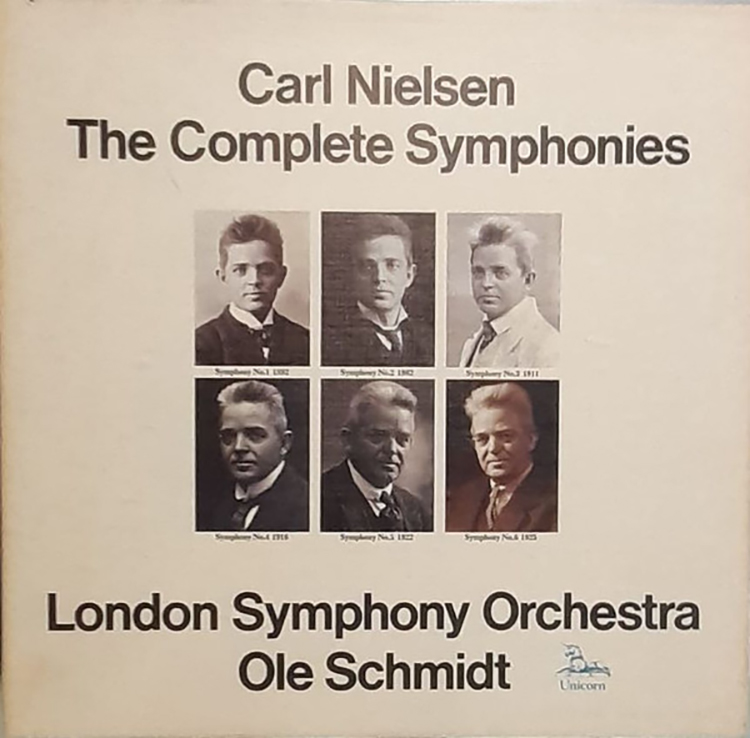
It was co-produced by the preeminent Nielsen musicologist Robert Simpson who wrote the standard English text “Carl Nielsen Symphonist” in 1952 when his name was unknown outside Denmark, with a second edition in 1979. In the Unicorn LP box, a lecture by Simpson was included on an extra LP. That has never made it to the CD reissues. The missing Robert Simpson lecture on Nielsen in the original LP box, “An introduction to the symphonies of Carl Nielsen, by Robert Simpson” is on YouTube and it makes a great introduction to the composer’s symphonies.
It would have been very hard to find the Unicorn box set in the US in 1974. This would have been expensive as an import.
In the USA a box set from Angel of all the Nielsen symphonies was recorded by Herbert Blomstedt with the Danish National Radio Symphony Orchestra in 1975. This Blomstedt box appears to have sold very well judging by the number of LP sets that are on offer on eBay. It was available in SQ Quad which degraded the stereo sound but that it is quad may be why so many were saved and are on eBay.
Aside from being the first easily available complete set in the US from Angel, it has performances that are not of interest now . A 2023 digital remastering has dramatically improved the sound but given the performance, it is not worth your time with it.
The same cannot be said of the Ole Schmidt Unicorn box . It was the first stereo LPs by a Danish conductor, steeped in the Nielsen performance tradition, he learned at the Royal Danish Academy of Music. Close to 50 years after it was released, it is still ranked among the top 10 complete sets and some critics put it in the top 5. Single symphonies also appear on critics’ lists of the 5 best.
It has been reissued on CD by the Alto–Musical Concepts budget label . It just went up to stream on Qobuz but not yet on Idagio.
The Catalog number is MSLC 2505. The price is just $15.00 on Amazon.
If you know and love Nielsen, this is the set to give to all your friends on your holiday gift list that are into classical music. The box says the recording was licensed to Alto by the conductor.
It’s difficult to gift a lossless download and in almost all cases your classical music friends will have no idea what to do with it. If they are streaming, it is with Bluetooth over an Apple iPhone to the audio system. The sound of your $15 present will be found excellent on the receiving end.
Lost but found again at the start of the CD era.
Classical LP sales crashed in the 70s, but the appearance of CDs in the 1980s created a flood of recordings of unknown composers which fortunately included Nielsen whose star had fallen by the mid-70s.

While an incomplete cycle on the small, Nordic, audiophile label, BIS started to appear in 1982 as very early CDs, Herbert Blomstedt got a second chance to do all the symphonies on CD from 1988 – 1990 when he was the music director of the San Francisco Symphony . The conclusion of this cycle in 1990 corresponds with the 125th birthday of Nielsen.
I did not highlight Symphony #6 in my survey of the early RCA – Columbia series since the Ormandy version is not available. The 6th is a complex work that represents a turn in Nielsen’s style in reaction to the 2nd German School of composition and some personal issues. Nothing else in the repertoire is like it but it takes more than a few words to explain. The best performance is hard to pick. The second performance with Blomstedt and the San Francisco Symphony is good. In 1990 when Blomstedt did the 6th symphony, for the 125th birthday in NYC, the Times critic wrote: “A Composer Whose Time Never Seems to Come.”
In 1992 Chandos released a box with the Russian conductor Gennady Rozhdestvensky.
Nielsen had made it to Russia but unfortunately, we would have to wait for the 150th birthday for a new CD set of the symphonies by an American orchestra and conductor.
The Bernstein recording of Mahler in the early to mid-1960s propelled him to be the composer on every orchestra’s season despite the expense of presenting his symphonies. Sibelius’s music had almost disappeared by the 60s but the 100th anniversary kicked him back to one of the most played composers today. Vaughan Williams, whose discovery, at least in the US, was also in the 1960s also made it from “who’s that?” to “gotta hear it!” And while Vaughan Williams does not get onto the orchestral stage in the US very often, he is all over the radio.
Nielsen got the same treatment attention in the 1960s, but he just did not stick with the average classical listener. The second attempt with the introduction of CD technology fared no better.
Unfortunately, all the productivity in the recording studio up to 2023 has not made his name more well-known.
Nielsen fans, many of whom are well-known critics and musicologists, have no idea what went wrong.
An LP album note, which I cannot locate, had the following story: “Sibelius, born in the same year, told Nielsen he would be better known than Beethoven but only when Beethoven had been forgotten.” Google has been of no help verifying this quote.
Tons of ink has been spilled comparing Sibelius and Nielsen which are very different despite both being from Nordic countries. The 150th birthday of the two composers came in 2015. The excitement that occurred among listeners at the 100th anniversary did not reoccur. We got a few Nielsen releases, performances, and radio play but Sibelius must have had 10 times the airtime. Past the 150th anniversary, we are back to radio silence for Nielsen.
His time has not come. I have no understanding of why this is so. For my part, I will continue to work to reverse it in this new column .
Next time I will look at some of the best recordings released around Nielsen’s 150th birthday.

